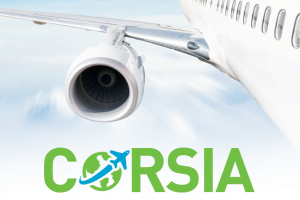商業(yè)版塊
Airlines and the climate
航空公司與氣候
Setting a new CORSIA
設(shè)立新的《國(guó)際航空碳抵消和減排計(jì)劃》
A carbon-intensive industry defangs an already mostly toothless offset scheme
碳密集型產(chǎn)業(yè)摧毀了基本上已經(jīng)失效的碳抵消計(jì)劃
“The worst year in the history of aviation” is how the International Air Transport Association (IATA) describes 2020. The global airline-industry body expects carriers’ revenues to fall by half and debt to swell by $120bn to $550bn. To cut costs airlines have grounded planes and put staff on unpaid leave.
國(guó)際航空運(yùn)輸協(xié)會(huì)(IATA)將2020年描述為“航空史上最糟糕的一年”。這家全球航空業(yè)機(jī)構(gòu)預(yù)計(jì),航空公司的收入將會(huì)減半,債務(wù)將增加1200億美元,達(dá)到5500億美元。為了削減成本,航空公司使飛機(jī)停飛,并讓員工無(wú)薪休假。

Another slashed expense is that of climate action. Aviation emits 3% of manmade carbon dioxide. That share could rise to 5-9% by 2050, according to the International Energy Agency, a forecaster. To curb these emissions, in 2013 the European Union tried to add international aviation to its emissions-trading programme, including flights connecting EU airports to those outside the bloc. The industry cried foul. In a compromise the International Civil Aviation Organisation (ICAO), an agency of the UN, devised the Carbon Offsetting and Reduction Scheme for International Aviation. CORSIA, as it is known for short, is due to start next year. It compels airlines to buy offsets for any additional CO2 produced by international flights above a baseline.
另一項(xiàng)削減開(kāi)支的措施與氣候行動(dòng)相關(guān)。航空業(yè)二氧化碳排放量占人類(lèi)制造的二氧化碳排放量的3%。據(jù)國(guó)際能源署預(yù)測(cè),到2050年,這一比例可能增至5-9%。為了減排,2013年,歐盟試圖將國(guó)際航空業(yè)納入其碳排放交易計(jì)劃,包括來(lái)往于歐盟機(jī)場(chǎng)內(nèi)外的航班。航空業(yè)為此叫苦不迭。聯(lián)合國(guó)下屬的國(guó)際民用航空組織(ICAO)作出妥協(xié),設(shè)計(jì)了《國(guó)際航空碳抵消和減排計(jì)劃》。《國(guó)際航空碳抵消和減排計(jì)劃》,簡(jiǎn)稱CORSIA,將于明年生效。這項(xiàng)計(jì)劃迫使航空公司對(duì)于超過(guò)基準(zhǔn)的國(guó)際航班產(chǎn)生的任何額外的二氧化碳進(jìn)行購(gòu)買(mǎi)抵消。
That baseline has become hotly contested. It was originally set at the industry’s average emissions for 2019 and 2020. Now emissions are forecast to fall by 37% this year, which would mean a lower baseline— and so, in time, higher offsetting costs. So IATA proposed using just emissions from just 2019 instead. On June 30th icao’s 36- member council agreed, at least for COASIA’s first three years.
碳排放基準(zhǔn)線飽受爭(zhēng)議。最初將2019年和2020年的航空業(yè)平均排放量設(shè)定為基準(zhǔn)。目前預(yù)計(jì)今年的碳排放量將減少37%,這意味著更低的基準(zhǔn)值以及更高的碳抵消開(kāi)支。因此,國(guó)際航協(xié)建議只使用2019年的排放量作為基準(zhǔn)。6月30日,由36個(gè)成員國(guó)組成的國(guó)際民航組織理事會(huì)同意,至少在《國(guó)際航空碳抵消和減排計(jì)劃》實(shí)施的前三年應(yīng)用這一基準(zhǔn)。
Environmental groups are up in arms. The scheme already lacked bite, since it is voluntary until 2027 and does not include domestic flights, about a third of the industry’s emissions. Countries representing three-quarters of aviation’s carbon footprint have signed up but flights between those which have opted in and those which have not are excluded. Dan Rutherford of the International Council on Clean Transportation, an NGO, calculates that on prepandemic trends the original plan would have covered only 9% of aviation emissions from 2021 to 2035 (when the scheme is scheduled to end).
然而,環(huán)保組織對(duì)此表示強(qiáng)烈不滿。這項(xiàng)計(jì)劃本身缺乏說(shuō)服力,因?yàn)樵?027年之前,這項(xiàng)計(jì)劃是自愿性質(zhì)的,而且計(jì)劃內(nèi)不包括國(guó)內(nèi)航班,而國(guó)內(nèi)航班的碳排放量大約占航空業(yè)的三分之一。產(chǎn)生航空業(yè)碳足跡四分之三的國(guó)家已經(jīng)簽署了協(xié)議,但往返選擇加入的國(guó)家和尚未加入的國(guó)家之間的航班則被排除在外。非政府組織國(guó)際潔凈運(yùn)輸理事會(huì)的丹·盧瑟福計(jì)算出,按照疫情前的趨勢(shì),在2021年至2035年(計(jì)劃結(jié)束)期間,原計(jì)劃只覆蓋航空排放量的9%。
譯文由可可原創(chuàng),僅供學(xué)習(xí)交流使用,未經(jīng)許可請(qǐng)勿轉(zhuǎn)載。












